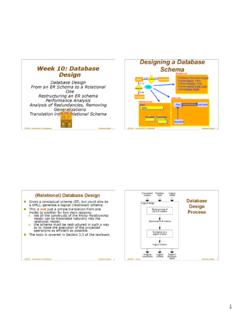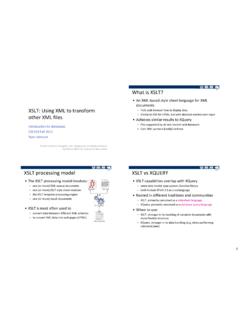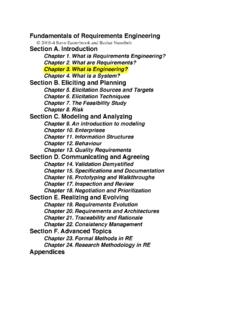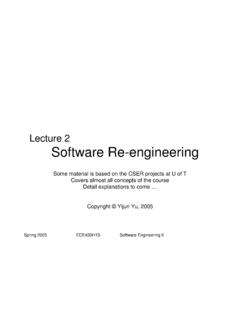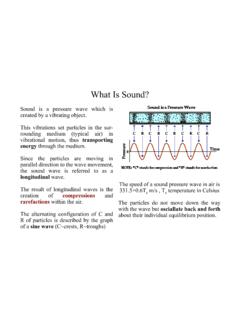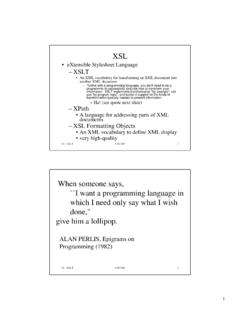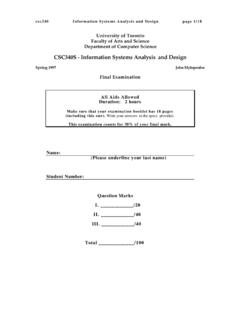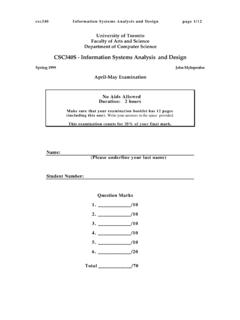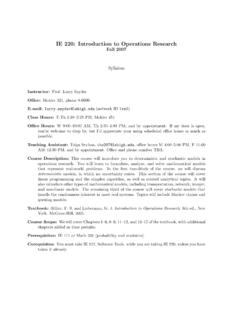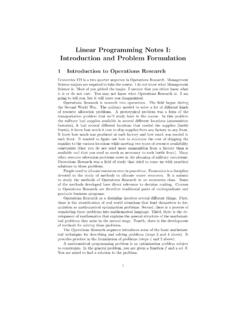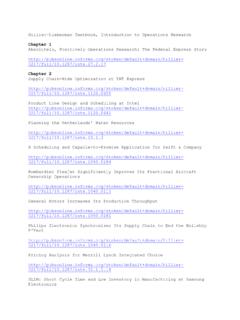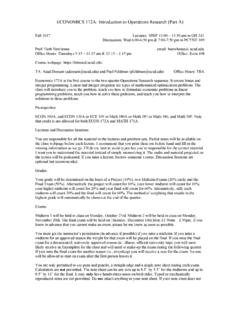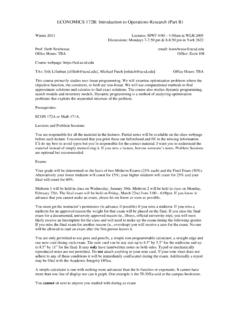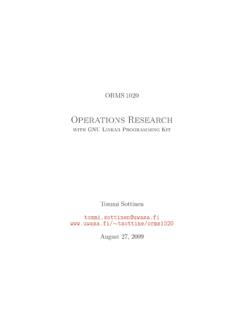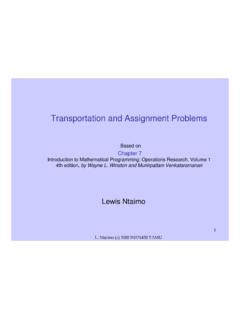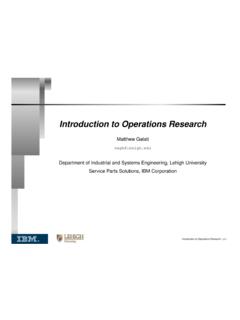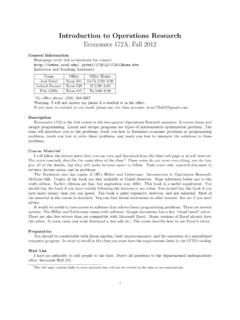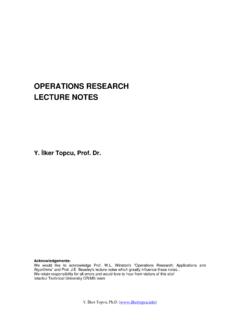Transcription of Introduction to Operations Research
1 Introduction toOperations ResearchDeterministic ModelsJURAJSTACHOD epartment of Industrial Engineering and Operations ResearchContents1 Mathematical modeling by formulation..32 Linear a linear program.. and further tricks..83 Solving linear method.. Elimination (FME)..134 Simplex form.. method by example.. phase Simplex method.. cases..235 Linear Algebra of linear equations..316 Sensitivity the objective function.. the right-hand side value.. example.. a variable/activity.. a constraint.. the left-hand side of a constraint.. interpretation.. Theorems and Feasibility.. LPs.. slackness..488 Other Simplex Simplex Method.
2 Simplex.. bounds.. Simplex with Upper Bounds.. Programming..579 Transportation Simplex Method..6010 Network Shortest Path Problem.. Minimum Spanning Tree.. Maximum Flow problem.. Minimum-cost Flow problem.. Network Simplex Algorithm.. Network Simplex Algorithm with capacitites.. Complete example.. Summary..8311 Game Pure and Mixed strategies.. Nonconstant-sum Games..8812 Integer Problem Formulation.. Cutting Planes.. Branch and Bound..9513 Dynamic Programming10314 Analysis of Algorithmic Complexity.. 115 PrefaceThese lecture notes were written during the Fall/Spring 2013/14 semesters to accompany lectures of the courseIEOR 4004: Introduction to Operations Research - Deterministic Models.
3 The notes were meant to provide a succintsummary of the material, most of which was loosely based on the bookWinston-Venkataramanan: Introduction toMathematical Programming (4th ed.), Brooks/Cole 2003. Other material (such as the dictionary notation) was adaptedfromChv atal: Linear Programming, Freeman 1983andDantzig-Thapa: Linear Programming, Springer-Verlag other bits were inspired by other lecture notes and sources on the Internet. These notes are not meant to replaceany book; interested reader will find more details and examples in the Winston book in particular. I would like to thankstudents that helped me correct numerous mistakes in the earlier versions of the notes.
4 Most likely all mistakes havenot been yet caught, and so the reader should exercise caution should there be inconsistencies in the text. I am passingon the notes to Prof. Strickland who will continue making adjustments to the material as needed for the upcomingofferings of the course. Of course, any suggestions for improvements are welcomed from anyone StachoJuly 26, 2014iv1 Mathematical modeling by exampleProduct mixA toy company makes two types of toys:toy soldiersandtrains. Each toy is produced in two stages, first it isconstructed in a carpentry shop, and then it is sent to a finishing shop, where it is varnished, vaxed, and polished.
5 Tomake one toy soldier costs $10 for raw materials and $14 for labor; it takes 1 hour in the carpentry shop, and 2 hoursfor finishing. To make one train costs $9 for raw materials and$10 for labor; it takes 1 hour in the carpentry shop, and1 hour for are 80 hours available each week in the carpentry shop,and 100 hours for finishing. Each toy soldier is sold for$27 while each train for $21. Due to decreased demand for toy soldiers, the company plans to make and sell at most40 toy soldiers; the number of trains is not restriced in any is the optimum (best) product mix ( , what quantities of which products to make) thatmaximizesthe profit(assuming all toys produced will be sold)?
6 Terminologydecision variables:x1,x2, .. ,xi, ..variable domains: values that variables can takex1,x2 0goal/objective:maximize/minimizeobjecti ve function: function to minimize/maximize2x1+5x2constraints: equations/inequalities3x1+2x2 10 ExampleDecision variables: x1= # of toy soldiers x2= # of toy trainsObjective: maximize profit $27 $10 $14=$3profit for selling one toy soldier 3x1profit (in $) for sellingx1toy soldier $21 $9 $10=$2profit for selling one toy train 2x2profit (in $) for sellingx2toy train z=3x1+2x2|{z}objective functionprofit for sellingx1toy soldiers andx2toy trains12 CHAPTER 1. MATHEMATICAL MODELING BY EXAMPLEC onstraints: producingx1toy soldiers andx2toy trains requires(a)1x1+1x2hours in the carpentry shop; there are 80 hours available(b)2x1+1x2hours in the finishing shop; there are 100 hours available the numberx1of toy soldiers produced should be at most 40 Variable domains: the numbersx1,x2of toy soldiers and trains must be non-negative (sign restriction)Max3x1+2x2x1+x2 802x1+x2 100x1 40x1,x2 0We call this aprogram.
7 It is alinearprogram, because the objective is a linear function of the decision variables, andthe constraints are linear inequalities (in the decision variables).BlendingA company wants to produce a certain alloy containing 30% lead, 30% zinc, and 40% tin. This is to be done by mixingcertain amounts of existing alloys that can be purchased at certain prices. The company wishes to minimize the are 9 available alloys with the following compositionand (%)20503030306040101030 Zinc (%)30402040303050301030 Tin (%)50105030401010608040 Cost ($/lb) adecisionvariablesx1,x2, .. ,x9wherexiis theamountof Alloyiin aunit of blendIn particular, the decision variables must satisfyx1+x2+.
8 +x9=1. (It is a common mistake to choosexitheabsoluteamount of Alloyiin the blend. That may lead to a non-linear program.)With that we can setup constraints and the objective + + + + + + + + [Cost] +x2+x3+x4+x5+x6+x7+x8+x9= + + + + + + + + [Lead] + + + + + + + + [Zinc] + + + + + + + + [Tin]Do we needallthe four equations?Product mix (once again)Furniture company manufactures four models of chairs. Eachchair requires certain amount of raw materials (wood/steel)to make. The company wants to decide on a production that maximizes profit (assuming all produced chair are sold).
9 The required and available amounts of materials are as ACTIVITY-BASED FORMULATION3 Chair 1 Chair 2 Chair 3 Chair 4 Total availableSteel11394,4000 (lbs)Wood49726,000 (lbs)Profit$12$20$18$40maximizeDecision variables:xi=the number of chairs of typeiproducedeachxiis non-negativeObjective function:maximize profitz=12x1+20x2+18x3+40x4 Costraints:at most4, 400lbs of steel available:x1+x2+3x3+9x4 4, 400at most6, 000lbs of wood available:4x1+9x2+7x3+2x4 6, 000 Resulting program:Max12x1+20x2+18x3+40x4=z[Profit] +x2+3x3+9x4 4, 400[Steel]4x1+9x2+7x3+2x4 6, 000[Wood]x1,x2,x3,x4 Activity-based formulationInstead of constructing the formulation as before (row-by-row), we can proceed by can view columns of the program asactivities.
10 An activity hasinputs: materials consumed per unit of activity(1lb of steel and 4lbs of wood)outputs: products produced per unit of activity($12 of profit)activity level: a level at which we operate the activity(indicated by a variablex1)Chair 1x11lb of steel4lbs of wood$12 of profitinputsoutputsactivityOperating the activity Chair 1 at levelx1means that we producex1chairs of type 1, each consuming 1lb of steel,4lbs of wood, and producing $12 of profit. Activity levels arealways assumed to materials/labor/profit consumed or produced by an activity are calleditems(correspond to rows).The effect of an activity on items ( the amounts of items that are consumed/produced by an activity) total amount of items available/supplied/required is called chooseobjectiveto be one of the items which we choose to maximize or step is to writematerialbalanceequationsthat express the flow of items in/out of activies and with respect tothe external 1.
